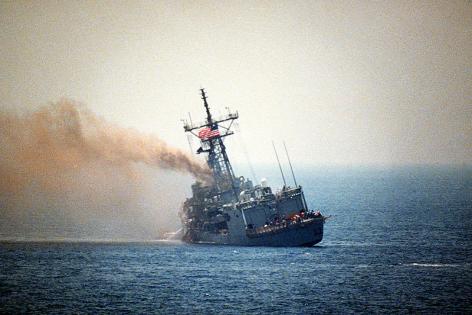Wow! your store has best selection of Air Force Patches I have seen. I just bought some and planing to buy more. Thank you again.
(707) 906-3361
USS Stark, a Perry class guided missile frigate, was under the command of Captain Glenn R. Brindel and was part of the Middle East Task Force. She was sailing off the Saudi Arabian coast near the Iran–Iraq War exclusion boundary, the area of sea off Iran and Iraq. The Iraqis attacked with a French built Dassault Mirage F1 armed with 1,500 pound Exocet missiles. It took off from the airbase of Shaibah at 20:00 and headed south into the Persian Gulf also along the coast. The aircraft was flying 5,000 feet above the water at 550 miles per hour.[citation needed] An AWACS plane on patrol nearby, with an American and Saudi Arabian crew, first detected the incoming Iraqi jet and informed the Stark which picked up the aircraft on radar, 200 miles out.[citation needed] When it came within view just before 10:00 pm, it was off the Stark's port side beam.
Captain Brindel was not alarmed[citation needed] and he ordered his radioman to send a message at 10:09, "Unknown aircraft, this is U.S. Navy warship on your 078 for twelve miles. Request you identify yourself." When the message was not responded to, a second was sent but still there was no reply. At 10:10 Captain Brindel was informed that the Iraqi aircraft had locked his Cyrano-IV fire-control radar onto the ship, then the F-1 fired a missile from twenty-two miles away and a second at fifteen miles. Suddenly the jet banked left and began to withdraw. Stark's STIR system failed to detect the incoming missiles and it was not until seconds[citation needed] before the first hit that the Americans discovered they were under fire.[citation needed] The first Exocet came in at just over ten feet above the sea[citation needed] and struck the port side hull near the bridge, it failed to detonate but rocket fuel ignited and caused a large fire which spread throughout the post office, the store room and the combat operations center.
The second Exocet struck the port side as well and exploded, leaving a ten by fifteen foot hole in the frigate's side. Electronics for the Stark's Standard missile defense went out and Captain Brindel did not order his men to return fire. The AWACS plane was still in the area and just after witnessing the attack, it radioed a nearby Saudi airbase to send aircraft for an interception but the ground controllers did not have the authority to order a sortie so the Iraqi jet escaped unharmed. Legally the American warship was allowed to attack any hostile aircraft within twenty miles. Twenty-nine men were killed in the explosion and fire, eight sailors died later of wounds and twenty-one others wounded. Two Americans of the thirty-seven were lost at sea.
Throughout the remainder of the night and the following day, the Americans fought the fire which burned for almost twenty-four hours. Captain Brindel also ordered the starboard side flooded so as to keep the hole on the port side above water, this helped keep the frigate from sinking. A distress call was sent out after the first missile hit, it was received by USS Waddell which was in the area. The Waddell arrived after the fire was under control and provided an escort for the Stark as she slowly made her way to Bahrain. The incident became the first successful anti-ship missile attack on a United States Navy warship.
